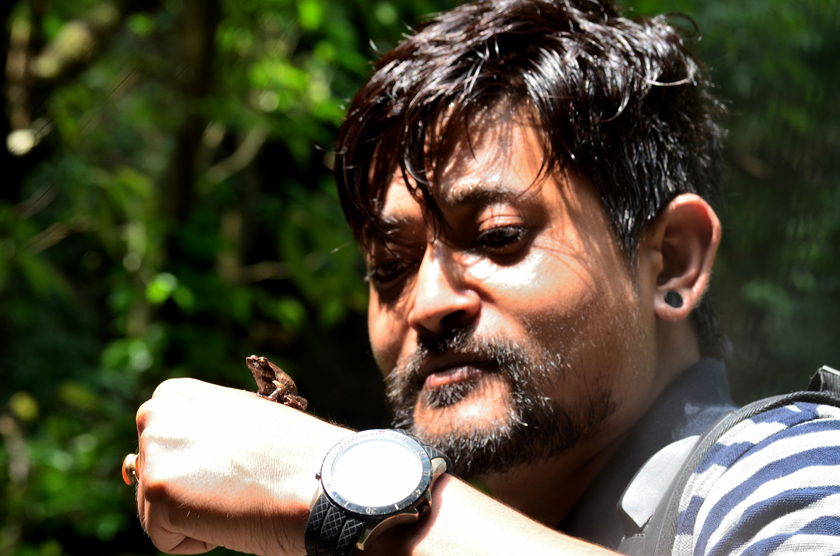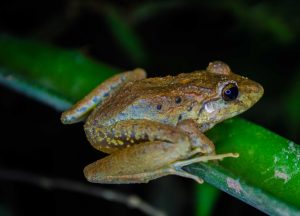
Monsoon brings with it puddles, umbrellas and rain boots. It also welcomes the songs of frogs. Frogs usually do not come up in middle of a conversation when we discuss animal conservation, but these amphibians have some impressive traits that need to be acknowledged.
Similarly, once you know the ecological significance of frogs, you will understand that like any other species, frogs are also in dire need of conservation. In my quest to get a more in-depth insight into the lives of frogs, I met one such individual who has dedicated his life to protecting these marvels of nature. Biraj Shrestha is a batrachologist (one who studies amphibians). He is an avid ‘frog lover’ who has been involved in research and conservation of amphibians, especially frogs, since 2012. His efforts have been recognised by various institutions such as the Rufford Small Grants and The Pollination Project Seed Grant among others. Shrestha was recently accorded with the Future Leader of Amphibian Conservation Award in 2017.
Excerpts from my interview with him:
Could you tell us why you decided to take up frog conservation. What it the story behind your passion?
My love for herpetology (study of amphibians) began after my graduation in 2008 as a stay-at-home guy. Thanks to the few TV stations that featured program on herps (amphibians and reptiles), I grew the passion.
Among the programmes I watched the most were Dr Brady Barr’s herping expeditions. He poked his head inside croc burrows, and that left an indelible impression on me.
I began exploring about these species through TV shows, books, the internet, journals and magazines. I even started conversation with the relevant people and so forth. But it was ironical that I used to get jitters holding a specimen as my greatest fear in childhood was none other than spooky reptiles. Geckos, snakes and lizards would scare the life out of me, but frogs were special and their rumbling echoes during rainy nights was music to the ears! Anyways, I overcame the fear with my growing interest on herps, year after year.
I went about pursuing my passion in herpetology, tailored it along with my academics and carried out my university level dissertation at the Manaslu Conservation Area (MCA) on herpetological inventory in 2012. Then I realised that the stream-dwelling frogs, locally known as paha, were being hunted widely by local community as frog meat is considered a local delicacy that would come free of cost. Hunting frogs is also considered a mode of recreation for school children and the youth.
Killing of paha has been rampant in the mountainous of Nepal from time immemorial. This spells grave danger for frogs as population of humans is growing rapidly. Thus, to resolve the situation, I have been trying to educate people to stop such practices as frogs around the world are in real danger due to human activities. The frog’s habitats are being altered, they are contracting diseases, and then there is pollution and climate change.
Why should people care about frogs?
Frogs play multiple ecological roles that ultimately benefit humankind. For example, tadpoles consume rotten leaves, dead animals, fish fecal pellets and other debris; they help keep water clean. They even compete with mosquito larvae for resources. Adult frogs feed on insects such as mosquitoes and flies that transfer disease to humans.
Similarly, frogs are an important food source for many predators like snakes, birds (hawks, eagles), fish and even some mammals (foxes and wild dogs). Thus, its disappearance will disturb the food web and cause negative impact on the ecosystem. Frogs also serve as bio indicators. They have permeable skin that easily absorbs any toxic chemical in their environment. Thus if they are healthy we can be confident that our environment is healthy.
Frogs produce a wide array of skin secretions, many of which have significant potential to improve human health through their use in medicine. Approximately 10% of the Nobel Prize in Physiology and Medicine have resulted from investigations that used frogs.
In Kathmandu, the Newars offer food to frogs in the month of Shrawan and even during Janai Purnima in a ritual called ‘Byan Janakewu’ (feeding the frogs). According to local mythology, it was the frogs who helped catch the demon Ghantakarna.
In rural Nepal, weddings are organised for frogs to appease the rain god. Farmers know that the monsoon has arrived when the frogs start croaking.
In an agricultural country such as Nepal, frogs are the farmers’ best friends. Many harmful insects such as swarming caterpillars (Spodetperamauritia), rice hispas (Hispaarmigera), paddy grasshoppers (Hieroglyphusbanian, H. orziovra, H. nigroreplates) and rice worms (Nymphuladepuntatis) damage crops. Frogs eat them and control the spread of pests. Thus, the croaking of frogs is always beneficial from the farmers’s point of view.
What is the present status of frogs in Nepal?
There are 7,529 known amphibian species across the world, of which 6,641 are Anura (frogs and toads), 683 Caudata (newts and salamanders), and 205 are Gymnophiona (caecilians). The total number of recognised species has increased by over 60 per cent since 1985. In Nepal, there are 53 species of amphibians (1 newt, 4 toads, 47 frogs and 1 caecilian).
Over 2,000 amphibian species are listed as endangered. One-third of the population (around 200 species) have already been extinct since 1979. Amphibian studies in Nepal took place more than 100 years ago (Hodgson’s period) but were only limited to preparation of checklists. The studies are fragmentary while mid- and far-west Nepal has not been explored for amphibians.
A total of 11 species of frogs are endemic to Nepal, inclusive of Scutigernepalensis (Khaptad high altitude toad), Amolopsnepalicus (Nepalese cascade frog), Limnonectesnepalensis (Nepalese cricket frog), Limnonectespierrei (Jhapa frog), Limnonectesteraiensis (Terai cricket frog), Paaercepeae (Bajhang frog), Paararica (Rara frog), Paarostandi (Mustang frog), Ranachitwanensis (Chitwan frog), Sphaerothecaswani (Swan’s burrowing frog) and Polypedates zed (Nepalese tree frog).

How is the future looking for frogs?
There are various aspects that can be considered as major gaps in Nepal. There is a serious absence of baseline data of amphibians of the whole country. Any research carried out therefore is not substantial to be brought to a valid conclusion. Also, there is a meagre assessment of the threat status nationwide.
There has not been much work done in the past to understand and evaluate the condition of frogs and their habitat and the grim situation thereof. There needs to be an intensive amphibian action plan that incorporates amphibian zoning areas in critical habitats. Moreover, amphibians are not listed under protected wildlife. That makes it impossible for national legal measures to be implemented for their conservation as a whole.
Besides the gaps, there are other substantial threats to frogs in Nepal just like in any other parts of the world. Rapid change in land use–from agricultural and earth-bound to more concrete and constructional structure–has acted as a blow to frog habitats.
There has also been an alarming increase in the use of pesticides in the fields, and this is affecting amphibians like frogs. Wetlands are drying up rapidly and the ones that are left also have fallen prey to pollution. Rapid deforestation and urbanisation contribute to the decline in frog’s population along with the notorious effects of climate change. Similarly excessive usage of frogs for vivisection is also hurting them.
Is there anything that can be done to save the frogs?
There are many measures that can be taken to create a safe world for frogs. These steps can start with small changes we bring to our daily lifestyle to much complex actions.
We need to rely less on on pesticides, ban disposal of waste in water bodies, use rechargeable batteries as batteries in general contain harmful toxic heavy metals like mercury, lead and cadmium that cause malformation in frogs.
So it’s better if we replaced the batteries with with rechargeable ones as approximately 15 billion batteries are produced each year. Similarly, there should be a regulation on collection of frogs in the mountain regions. Likewise, medical researchers who are using frogs for dissection need to switch to virtual dissection software like Digital Frog 2.5. That would spare the lives of these endangered amphibians.
By making simple and conscious changes to our lifestyle, we can make a difference in the lives of these creatures. After all, we all live in a single macrocosm of ecological interdependence.




















